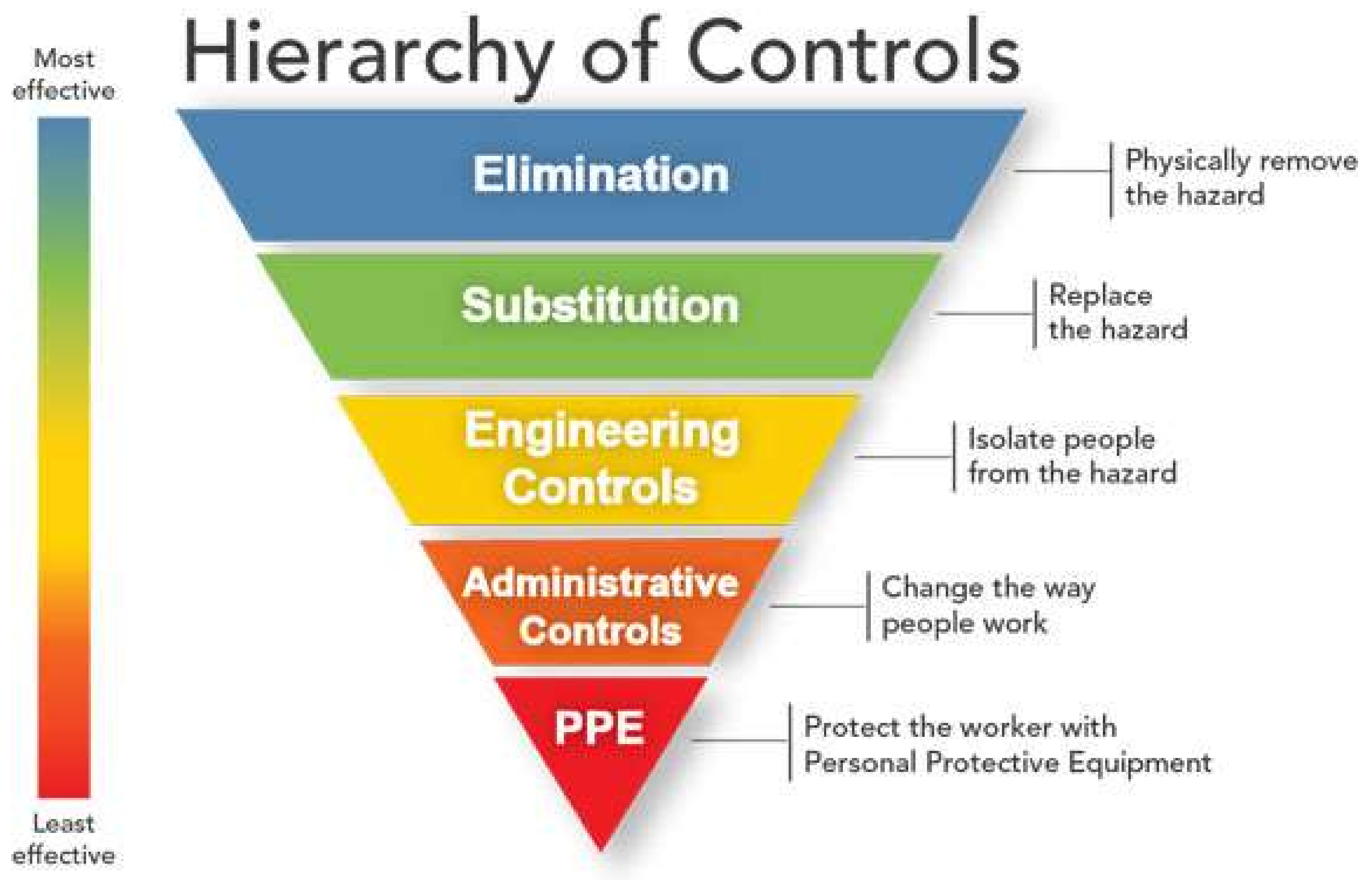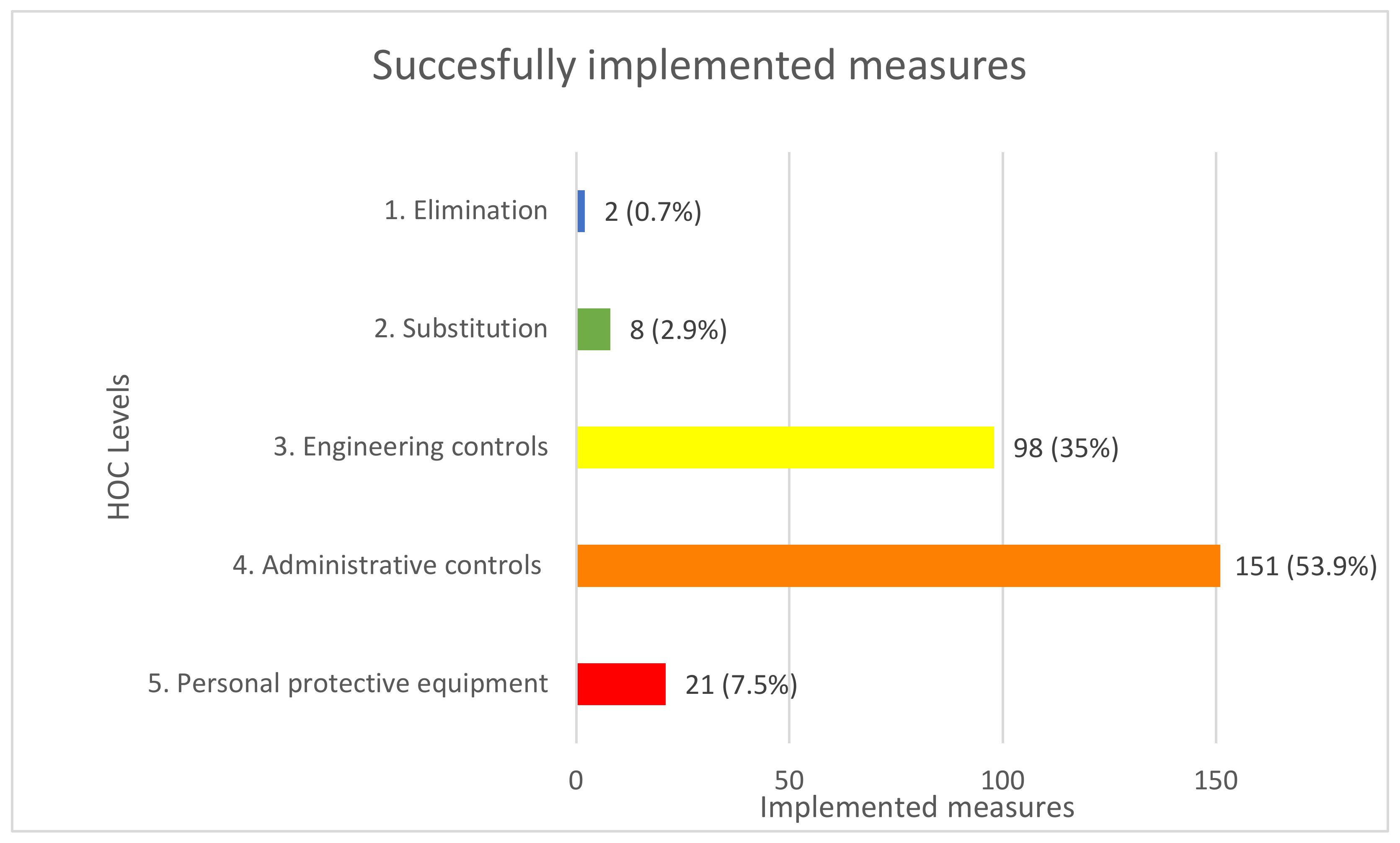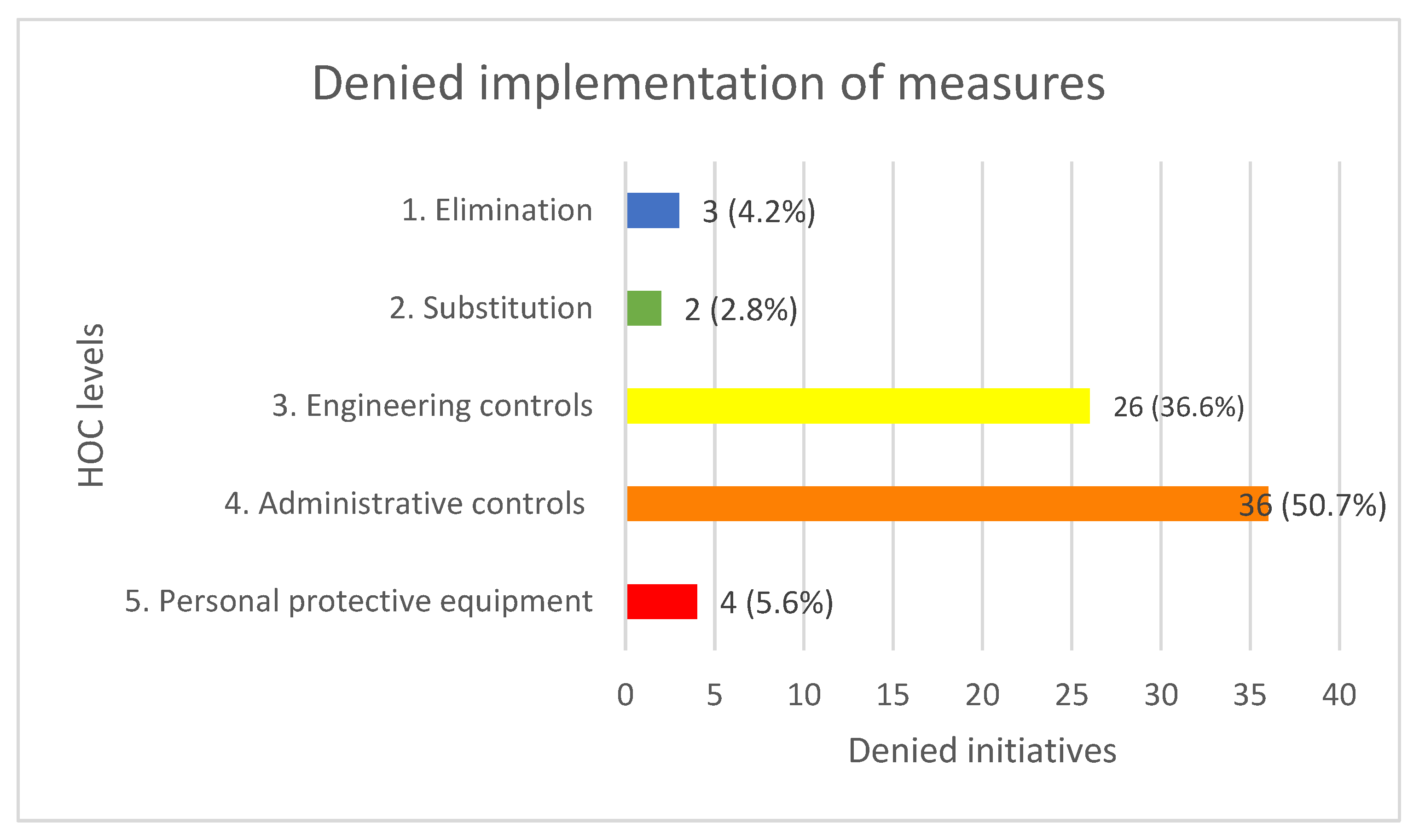The Hierarchy of Controls as an Approach to Visualize the Impact of Occupational Safety and Health Coordination
Abstract
:1. Introduction
Existing Research on OSH Coordination
2. Materials and Methods
2.1. The Hierarchy of Controls
2.2. Elimination
2.3. Substitution
2.4. Engineering Controls
2.5. Administrative Controls
2.6. Personal Protective Equipment (PPE)
3. Methods
3.1. Participants
3.2. Observational and Analytical Approach
4. Results
4.1. Implemented Measures
4.2. Eliminations
4.3. Substitutions
4.4. Engineering Controls
4.5. Administrative Controls
4.6. Personal Protective Equipment
5. Denied Measures
5.1. Eliminations
5.2. Substitutions
5.3. Engineering Controls
5.4. Administrative Controls
5.5. Personal Protective Equipment
6. Discussion
Author Contributions
Funding
Institutional Review Board Statement
Informed Consent Statement
Data Availability Statement
Conflicts of Interest
References
- Eurostat. An International Comparison of the Cost of Work-Related Accidents and Illnesses|Safety and Health at Work EU-OSHA. Available online: https://osha.europa.eu/en/publications/international-comparison-cost-work-related-accidents-and-illnesses (accessed on 12 January 2022).
- Nørregaard, G. Arbejdsforhold Indenfor Dansk Haandværk og Industri 1857–1899; Instituttet for Historie og Samfundsøkonomi: Gyldendal, Denmark, 1943. [Google Scholar]
- Swuste, P.; Frijters, A.; Guldenmund, F. Is it possible to influence safety in the building sector?: A literature review extending from 1980 until the present. Saf. Sci. 2012, 50, 1333–1343. [Google Scholar] [CrossRef]
- Lingard, H. Occupational health and safety in the construction industry. Constr. Manag. Econ. 2013, 31, 505–514. [Google Scholar] [CrossRef]
- Grill, M.; Nielsen, K.; Grytnes, R.; Pousette, A.; Törner, M. The leadership practices of construction site managers and their influence on occupational safety: An observational study of transformational and passive/avoidant leadership. Constr. Manag. Econ. 2018, 37, 278–293. [Google Scholar] [CrossRef]
- Eurostat. Health and Safety at Work. Available online: https://ec.europa.eu/eurostat/web/health/health-safety-work (accessed on 12 January 2022).
- Ajslev, J.Z.; Møller, J.L.; Persson, R.; Andersen, L.L. Trading health for money: Agential struggles in the (re)configuration of subjectivity, the body and pain among construction workers. Work Employ. Soc. 2016, 31, 887–903. [Google Scholar] [CrossRef]
- Thiel, D. Builders—Class, Gender and Ethnicity in the Construction Industry; Routledge: Abingdon, UK, 2012. [Google Scholar]
- Oswald, D.; Ahiaga-Dagbui, D.D.; Sherratt, F.; Smith, S.D. An industry structured for unsafety? An exploration of the cost-safety conundrum in construction project delivery. Saf. Sci. 2020, 122, 104535. [Google Scholar] [CrossRef]
- Pryor, P.; Hale, A.; Hudson, D. Development of a global framework for OHS professional practice. Saf. Sci. 2019, 117, 404–416. [Google Scholar] [CrossRef]
- Provan, D.J.; Dekker, S.W.A.; Rae, A.J. Bureaucracy, influence and beliefs: A literature review of the factors shaping the role of a safety professional. Saf. Sci. 2017, 98, 98–112. [Google Scholar] [CrossRef]
- Aulin, R.; Capone, P. The Role of Health and Safety Coordinator in Sweden and Italy Construction Industry; Lund University: Lund, Sweden, 2010; p. 15. [Google Scholar]
- Carmen, R.M.; German, M.; Carlos, R.J.; Javier, O. Role of the Civil Engineer as a Coordinator of Safety and Health Matters within the Construction Sector. J. Prof. Issues Eng. Educ. Pract. 2008, 134, 152–157. [Google Scholar]
- Brandt, M.; Wilstrup, N.M.; Jakobsen, M.D.; Van Eerd, D.; Andersen, L.L.; Ajslev, J.Z.N. Engaging Occupational Safety and Health Professionals in Bridging Research and Practice: Evaluation of a Participatory Workshop Program in the Danish Construction Industry. Int. J. Environ. Res. Public Health 2021, 18, 8498. [Google Scholar] [CrossRef]
- Daudigeos, T. In Their Profession’s Service: How Staff Professionals Exert Influence in Their Organization. J. Manag. Stud. 2013, 50, 722–749. [Google Scholar] [CrossRef]
- Møller, J.L.; Kines, P.; Dyreborg, J.; Andersen, L.L.; Ajslev, J.Z.N. The competences of successful safety and health coordinators in construction projects. Constr. Manag. Econ. 2020, 39, 199–211. [Google Scholar] [CrossRef]
- Provan, D.J.; Dekker, S.W.A.; Rae, A.J. Benefactor or burden: Exploring the professional identity of safety professionals. J. Saf. Res. 2018, 66, 21–32. [Google Scholar] [CrossRef]
- Rae, A.; Provan, D. Safety work versus the safety of work. Saf. Sci. 2019, 111, 119–127. [Google Scholar] [CrossRef]
- Antonsen, S. Safety culture and the issue of power. Saf. Sci. 2009, 47, 183–191. [Google Scholar] [CrossRef]
- Choudhry, R.M.; Fang, D.; Mohamed, S. The nature of safety culture: A survey of the state-of-the-art. Saf. Sci. 2007, 45, 993–1012. [Google Scholar] [CrossRef]
- Gherardi, S.; Nicolini, D. Learning the Trade: A Culture of Safety in Practice. Organization 2002, 9, 191–223. [Google Scholar] [CrossRef]
- Ajslev, J.Z.N.; Dastjerdi, E.L.; Dyreborg, J.; Kines, P.; Jeschke, K.C.; Sundstrup, E.; Jakobsen, M.D.; Fallentin, N.; Andersen, L.L. Safety climate and accidents at work: Cross-sectional study among 15,000 workers of the general working population. Saf. Sci. 2017, 91, 320–325. [Google Scholar] [CrossRef]
- Kines, P.; Lappalainen, J.; Mikkelsen, K.L.; Olsen, E.; Pousette, A.; Tharaldsen, J.; Tómasson, K.; Törner, M. Nordic Safety Climate Questionnaire (NOSACQ-50): A new tool for diagnosing occupational safety climate. Int. J. Ind. Ergon. 2011, 41, 634–646. [Google Scholar] [CrossRef]
- Zohar, D. Thirty years of safety climate research: Reflections and future directions. Accid. Anal. Prev. 2010, 42, 1517–1522. [Google Scholar] [CrossRef] [PubMed]
- Uhrenholdt Madsen, C.; Hasle, P.; Limborg, H.J. Professionals without a profession: Occupational safety and health professionals in Denmark. Saf. Sci. 2019, 113, 356–361. [Google Scholar] [CrossRef] [Green Version]
- CCOHS. Hazard Control; CCOHS: Hamilton, ON, Canada, 2019. [Google Scholar]
- Toolbox-Træning; Forbedring af Formænds Planlægnings-Og Kommunikationsfærdigheder i Byggebranchen. Available online: https://amff.dk/media/11642/toolbox-slutrapport.pdf (accessed on 12 January 2022).
- NIOSH. Hierarchy of Controls; NIOSH: Washington, DC, USA, 2015.
- Pirzadeh, P. A Social Network Perspective on Design for Construction Safety. Ph.D. Thesis, RMIT University, Melbourne, VIC, Australia, 2018. [Google Scholar]
- Manuele, F.A. Achieving Risk Reduction, Effectively. Process Saf. Environ. Prot. 2006, 84, 184–190. [Google Scholar] [CrossRef]
- Zhao, D.; McCoy, A.P.; Kleiner, B.M.; Smith-Jackson, T.L. Control measures of electrical hazards: An analysis of construction industry. Saf. Sci. 2015, 77, 143–151. [Google Scholar] [CrossRef]
- Szymberski, R. Construction project safety planning. Tappi J. 1997, 80, 69–74. [Google Scholar]
- Lingard, H.; Pirzadeh, P.; Blismas, N.; Wakefield, R.; Kleiner, B. Exploring the link between early constructor involvement in project decision-making and the efficacy of health and safety risk control. Constr. Manag. Econ. 2014, 32, 918–931. [Google Scholar] [CrossRef]
- Dalkey, N.C. Delphi. 1967. Available online: http://www.rand.org/pubs/papers/P3704.html (accessed on 12 January 2022).
- Flyvbjerg, B. Five Misunderstandings About Case-Study Research. Qual. Inq. 2006, 12, 219–245. [Google Scholar] [CrossRef] [Green Version]
- Nvivo 11; QSR International Pty Ltd.: Hawthorn East, VIC, Australia, 2015.
- Ajslev, J.Z.N.; Møller, J.L. Experts, Challengers and Champions—On the relational roles and practices of OHS coordinators in the Danish construction industry; Under review.
- Ajslev, J.Z.; Møller, J.L.; Nimb, I.E.E. The Professional Identities of Occupational Safety and Health Coordinators—Puzzle-Piece Caretakers or Necessary Evils; Under review.
- Hale, A.R. Occupational health and safety professionals and management: Identity, marriage, servitude or supervision? Saf. Sci. 1995, 20, 233–245. [Google Scholar] [CrossRef]
- Atkinson, A.R.; Westall, R. The relationship between integrated design and construction and safety on construction projects. Constr. Manag. Econ. 2010, 28, 1007–1017. [Google Scholar] [CrossRef]
- Ghodrati, N.; Yiu, T.W.; Wilkinson, S. Unintended consequences of management strategies for improving labor productivity in construction industry. J. Saf. Res. 2018, 67, 107–116. [Google Scholar] [CrossRef] [PubMed]
- Lingard, H.; Saunders, L.; Pirzadeh, P.; Blismas, N.; Kleiner, B.; Wakefield, R. The relationship between pre-construction decision-making and the effectiveness of risk control. Eng. Constr. Arch. Manag. 2015, 22, 108–124. [Google Scholar] [CrossRef]



| Type of Implemented Substitutions | No. of Implemented Measures |
|---|---|
| Use of technical assistive devices | 5 |
| Alternative chemical product | 1 |
| Ergonomic space for tying rebar on site | 1 |
| Platform for materials instead of in-building transport | 1 |
| Type of Implemented Engineering Controls | No. of Implemented Measures |
|---|---|
| Improved access paths | 23 |
| Safety railing | 21 |
| Logistic plan | 12 |
| Move materials from access paths | 11 |
| Procedures for crane work, handling poisoned dirt or concrete montage in design material | 9 |
| Protective cape on rebar, tying fire extinguishers, replacement of worn electrical wires | 7 |
| Proper excavation degrees or digging boxes | 5 |
| Safety gear or dust suction on machines | 4 |
| Lighting on paths | 3 |
| Specific scaffolding for tasks | 2 |
| Improve column safety | 1 |
| Type of Implemented Administrative Controls | No. of Implemented Measures |
|---|---|
| Safety meeting | 44 |
| Perform safety walk | 20 |
| Revise PSS or risk log | 13 |
| Facilitate safety induction | 11 |
| Facilitate startup or process workshop | 8 |
| Demand risk assessment from entrepreneur | 7 |
| Discuss safety at other meeting | 7 |
| Specify OSH management procedure in design material | 6 |
| Specify communication plan in design material | 6 |
| Tutor a colleague in risk assessment or other OSH | 5 |
| Updated visual construction site plan on site | 5 |
| Put up safety signs | 5 |
| Plan social events and external communication (e.g., with municipalities or citizens) | 4 |
| Plan helmet/noise protection campaign | 4 |
| Conduct design phase to execution phase transition meeting | 4 |
| Near-miss accident evaluation meeting | 2 |
| Type of Implemented Personal Protective Equipment | No. of Implemented Measures |
|---|---|
| Use of helmets | 10 |
| Use of fall equipment | 3 |
| Use of noise protection | 3 |
| Use of sunscreen | 1 |
| Use of safety glasses | 1 |
| Use of safety shoes | 1 |
| Use of safety masks | 1 |
| Use of fire extinguisher nearby | 1 |
| Type of Denied Engineering Controls | No. of Denied Initiatives |
|---|---|
| Removing materials from access paths | 5 |
| Safety railing | 5 |
| Improving access paths | 4 |
| Logistic plan | 3 |
| Safety gear or dust suction on machines | 2 |
| Protective cape on rebar, tying fire extinguishers, replacement of worn electrical wires | 2 |
| Proper excavation degrees or digging boxes | 2 |
| Specific scaffolding for tasks | 2 |
| Lighting on paths | 1 |
| Type of Denied Administrative Controls | No. of Denied Initiatives |
|---|---|
| Specify OSH management procedure in design material | 11 |
| Safety meeting | 8 |
| Facilitate safety introduction | 4 |
| OSH engagement initiative | 3 |
| Specify communication plan in design material | 3 |
| Facilitate startup or process workshop | 1 |
| Near-miss accident analysis | 1 |
| Helmet campaign | 1 |
| Demand risk assessment | 1 |
| Truck certificate | 1 |
| Alcohol policy | 1 |
| Conduct design phase to execution phase transition meeting | 1 |
Publisher’s Note: MDPI stays neutral with regard to jurisdictional claims in published maps and institutional affiliations. |
© 2022 by the authors. Licensee MDPI, Basel, Switzerland. This article is an open access article distributed under the terms and conditions of the Creative Commons Attribution (CC BY) license (https://creativecommons.org/licenses/by/4.0/).
Share and Cite
Ajslev, J.Z.N.; Møller, J.L.; Andersen, M.F.; Pirzadeh, P.; Lingard, H. The Hierarchy of Controls as an Approach to Visualize the Impact of Occupational Safety and Health Coordination. Int. J. Environ. Res. Public Health 2022, 19, 2731. https://doi.org/10.3390/ijerph19052731
Ajslev JZN, Møller JL, Andersen MF, Pirzadeh P, Lingard H. The Hierarchy of Controls as an Approach to Visualize the Impact of Occupational Safety and Health Coordination. International Journal of Environmental Research and Public Health. 2022; 19(5):2731. https://doi.org/10.3390/ijerph19052731
Chicago/Turabian StyleAjslev, Jeppe Z. N., Jeppe L. Møller, Malene F. Andersen, Payam Pirzadeh, and Helen Lingard. 2022. "The Hierarchy of Controls as an Approach to Visualize the Impact of Occupational Safety and Health Coordination" International Journal of Environmental Research and Public Health 19, no. 5: 2731. https://doi.org/10.3390/ijerph19052731
APA StyleAjslev, J. Z. N., Møller, J. L., Andersen, M. F., Pirzadeh, P., & Lingard, H. (2022). The Hierarchy of Controls as an Approach to Visualize the Impact of Occupational Safety and Health Coordination. International Journal of Environmental Research and Public Health, 19(5), 2731. https://doi.org/10.3390/ijerph19052731






